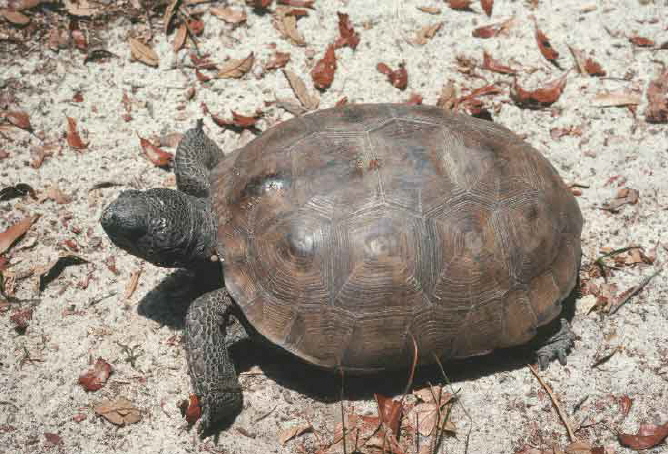- Gopherus polyphemus
Taxobox
name = Gopher Tortoise
status = VU
status_system = iucn2.3

image_size = 240px
image_caption = Gopher Tortoise, "Gopherus polyphemus"
regnum =Animal ia
phylum =Chordata
classis = Sauropsida
ordo =Testudines
subordo =Cryptodira
superfamilia =Testudinoidea
familia =Testudinidae
genus = "Gopherus "
species = "G. polyphemus"
binomial = "Gopherus polyphemus"
binomial_authority = Daudin, 1802The Gopher Tortoise ("Gopherus polyphemus") is atortoise species native to thecoastal plain s of theUnited States . They are most common to the state of Florida, but their range also extends to Georgia,Alabama , andMississippi , as well as the extreme southeastern corner ofSouth Carolina .Description
Gopher tortoises are medium-sized, with an average adult length of convert|10|in|mm and weight of convert|9|lb|abbr=on. Their
carapace is primarily a solid chocolate brown, gray, or black, and theirplastron is generally ayellow or tan. Hatchlings are lighter in color. Males are distinguished from females by their concave plastron and longer tail.Gopher tortoises is one of only four species of tortoise in the genus "
Gopherus ", the only genus of tortoises native toNorth America .Gopher tortoise males have two rounded
scent gland s under thechin to mark territory.Habitat and behavior
The Gopher Tortoise, like other tortoises of the genus "Gopherus", is known for its digging ability. Gopher Tortoises often dig
burrow s several feet deep into the ground, where they spend the majority of their time. The burrows are generally located in dry places such assandhill s,flatwood s,prairie s, andcoastal dune s. Except during breeding season, gopher tortoises are solitairy animals, inhabiting a small-home range. Within their range they dig several burrows.The Florida gopher tortoise is considered a threatened species in the United States. It is particularly common in
longleaf pine forests. Because of the destruction of longleaf pine forests and their replacement withloblolly pine forests, its numbers have dwindled in these areas.Captive breeding programs exist at severalzoos .Diet and reproduction
Gopher tortoises are herbivores. The bulk of their diet consists of grasses, such as
wiregrass , but they also consume berries, otherfruit , and even scavengecarrion .Gopher tortoises mate in late spring, during the months of April and May. The female lays between 3 and 15 eggs in a sandy mound somewhere near her burrow. The eggs incubate and hatch in around 70 to 100 days. Hatchlings initially will spend time sheltering in their mother's burrow but soon wander off on their own. Maturity is not reached until 10-15 years of age.
Conservation concerns
Conversion of gopher tortoise habitat to urban areas, croplands, and pasturelands along with adverse forest management practices has drastically reduced historic range of the gopher tortoise. Taking gopher tortoises for sale or use as food or pets has also had a serious effect on some populations. The seriousness of the loss of adult tortoises is magnified by the length of time required for tortoises to reach maturity and their low reproductive rate. Current estimates of human predation and road mortality alone are at levels that could offset any annual addition to the population. Sightings of gopher tortoises have become rare in many areas and the ones sighted are much smaller than in the past (Diemer 1984). A number of other species also prey upon gopher tortoises including the raccoon, who is the primary egg and hatchling predator; gray foxes; striped skunks; armadillos; dogs; snakes; and raptors. Imported
fire ants also have been known to prey on hatchlings. Reported clutch and hatchling losses often approach 90 percent (Landers et al., 1980). Many Gopher tortoises (Florida) have been destroyed as developers have hadcarte blanche to bulldose over them alive. This has changed as of 07/30/07 with new legislation enacted in Florida. This legislation is to end the Incidental Take Permit (IT).s, like the cotton mouse ("Peromyscus gossypinus").
As the gopher tortoise numbers decrease, the populations of the species which are dependent on them also dwindle. Accordingly, gopher tortoises are listed as an
endangered species .References
* Listed as Vulnerable (VU A1acde v2.3)
* [http://www.nbbd.com/godo/ef/gtortoise/ Enchanted Forest Nature Sanctuary: Gopher Tortoise]
* [http://www.uga.edu/srel/edpubs/gopher.htm Savannah River Ecology Laboratory: Gopher Tortoise Fact Sheet]External links
* U.S. Fish & Wildlife Service. [http://ecos.fws.gov/tess_public/TESSWebpage Threatened and Endangered Species System (TESS)] .
Wikimedia Foundation. 2010.
